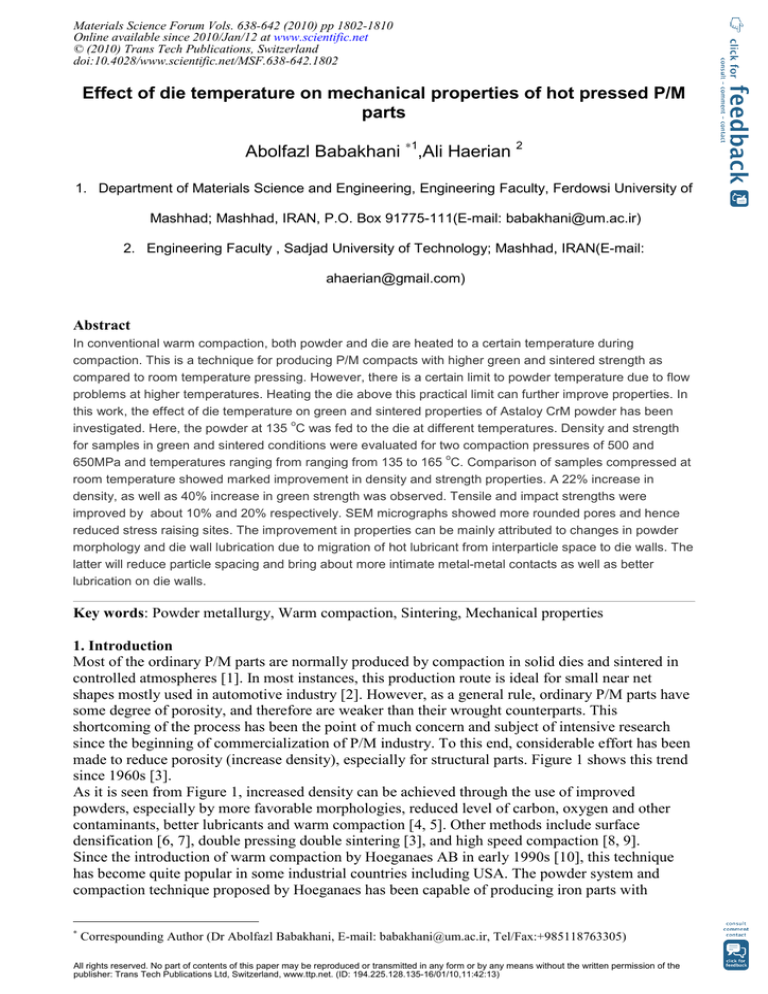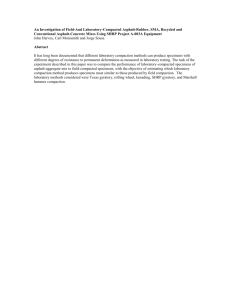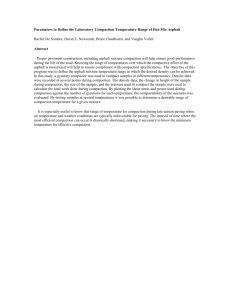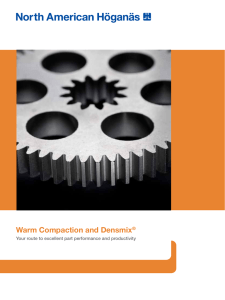
Materials Science Forum Vols. 638-642 (2010) pp 1802-1810
Online available since 2010/Jan/12 at www.scientific.net
© (2010) Trans Tech Publications, Switzerland
doi:10.4028/www.scientific.net/MSF.638-642.1802
Effect of die temperature on mechanical properties of hot pressed P/M
parts
Abolfazl Babakhani ∗1,Ali Haerian 2
1. Department of Materials Science and Engineering, Engineering Faculty, Ferdowsi University of
Mashhad; Mashhad, IRAN, P.O. Box 91775-111(E-mail: babakhani@um.ac.ir)
2. Engineering Faculty , Sadjad University of Technology; Mashhad, IRAN(E-mail:
ahaerian@gmail.com)
Abstract
In conventional warm compaction, both powder and die are heated to a certain temperature during
compaction. This is a technique for producing P/M compacts with higher green and sintered strength as
compared to room temperature pressing. However, there is a certain limit to powder temperature due to flow
problems at higher temperatures. Heating the die above this practical limit can further improve properties. In
this work, the effect of die temperature on green and sintered properties of Astaloy CrM powder has been
o
investigated. Here, the powder at 135 C was fed to the die at different temperatures. Density and strength
for samples in green and sintered conditions were evaluated for two compaction pressures of 500 and
o
650MPa and temperatures ranging from ranging from 135 to 165 C. Comparison of samples compressed at
room temperature showed marked improvement in density and strength properties. A 22% increase in
density, as well as 40% increase in green strength was observed. Tensile and impact strengths were
improved by about 10% and 20% respectively. SEM micrographs showed more rounded pores and hence
reduced stress raising sites. The improvement in properties can be mainly attributed to changes in powder
morphology and die wall lubrication due to migration of hot lubricant from interparticle space to die walls. The
latter will reduce particle spacing and bring about more intimate metal-metal contacts as well as better
lubrication on die walls.
Key words: Powder metallurgy, Warm compaction, Sintering, Mechanical properties
1. Introduction
Most of the ordinary P/M parts are normally produced by compaction in solid dies and sintered in
controlled atmospheres [1]. In most instances, this production route is ideal for small near net
shapes mostly used in automotive industry [2]. However, as a general rule, ordinary P/M parts have
some degree of porosity, and therefore are weaker than their wrought counterparts. This
shortcoming of the process has been the point of much concern and subject of intensive research
since the beginning of commercialization of P/M industry. To this end, considerable effort has been
made to reduce porosity (increase density), especially for structural parts. Figure 1 shows this trend
since 1960s [3].
As it is seen from Figure 1, increased density can be achieved through the use of improved
powders, especially by more favorable morphologies, reduced level of carbon, oxygen and other
contaminants, better lubricants and warm compaction [4, 5]. Other methods include surface
densification [6, 7], double pressing double sintering [3], and high speed compaction [8, 9].
Since the introduction of warm compaction by Hoeganaes AB in early 1990s [10], this technique
has become quite popular in some industrial countries including USA. The powder system and
compaction technique proposed by Hoeganaes has been capable of producing iron parts with
∗
Correspounding Author (Dr Abolfazl Babakhani, E-mail: babakhani@um.ac.ir, Tel/Fax:+985118763305)
All rights reserved. No part of contents of this paper may be reproduced or transmitted in any form or by any means without the written permission of the
publisher: Trans Tech Publications Ltd, Switzerland, www.ttp.net. (ID: 194.225.128.135-16/01/10,11:42:13)
Materials Science Forum Vols. 638-642
1803
densities exceeding 7.4g/cm3 by die compaction and single cycle sintering at low temperature
(below 1150 o C) [10].
Figure1. 30 years of density improvements in powder metallurgy
This process which utilizes preheated tools [11], yields improved mechanical properties. Here, due
to the change in the morphology of the sintered material, higher average densities are obtained.
There is also less variation of density within the compact as compared to parts made by
conventional press and sintered material. Since the yield strength of the powdered material is
reduced at higher temperatures, higher green strength is obtained using the same compaction
pressure. For iron powder compacted at 150 o C, a 3% reduction in yield strength has been reported
[12].
Warm compaction may be employed to most powder-material systems. More closed tolerances and
improved properties are expected, and due to higher green density, machining of green parts
becomes possible. Some of the more important reasons for using this technique are;
• Increasing green density from 0.1 to 0.3g/cm3,
• Increasing green strength from 50 to 100%,
• Reduced green part defects,
• Improved machinability, and
• Longer tool life due to use of lower pressures.
2. Materials and methods
The material used for this research was Hoeganaes Astaloy CrM. It has been shown that apparent
density and flow characteristics of the powder does not vary appreciably at temperatures up to
135oC. However, both apparent density and time to flow increase rather sharply above this
temperature. This may cause some scatter in weight of compacts with small changes in temperature
[10]. To eliminate this possibility, the powder temperature was kept constant at 130oC, and the die
temperature was varied at three temperatures of 130oC, 150oC and 165oC compaction pressure for
all samples were 650MPa.
Six 250 watts pen-type heating elements were embedded in the die wall (Figure2).
1804
THERMEC 2009
Figure2. Die for preparing of sample tests (1-Uper punch 2-Down punch 3-Band heater 4-Samples
5-Heating accessories)
Dewaxing was done for 20 minutes in pure nitrogen at 600oC, and sintering in 90N2/10H2
atmosphere in a tunnel furnace. Green density was calculated using geometrical methods, while
sintered density was measured by Archimedes technique.
Tension test was done according to ASTM E8 in a 250 kN Zwick machine. Three-point bend tests
for green and sintered samples were carried out in the same machine. A 50J Charpy machine was
used for impact tests.
3. Results and discussion
Figure 3 show that the relative density of the compacts reached 96% of theoretical density at
compaction pressure of 650MPa and 165oC die temperature. Such a high green density my be
attributed to the rearrangement of the particles due to lateral movement during warm compaction
[10]. In conventional cold pressing, there is very little lateral movement of the powder particles, and
the dominant mode of particle rearrangement would be through breakage of bridges under uniaxial
compaction force.
3.1. Density
Figure 4 and 5 shows variation of density with die wall temperature at two different compaction
pressures of 500MPa and 650MPa respectively. These two figures show a linear increase in green
density with die temperature up to 150oC, which is good agreement with previous findings [10].
Beyond 150oC, there is little increase in green density. Furthermore, it is observed that the density
of samples compacted at 165oC and 650MPa decrease by 0.03g/cm3 (from 7.20g/cm3 to 7.17g/cm3)
after sintering. This may be due to higher strength of the green compact resulting in partial
entrapment of gases during evaporation or decomposition of the lubricant.
Materials Science Forum Vols. 638-642
1805
Figure3. Relative density of green samples compacted at 500 and 650 MPa
Relative density
98.0
Relative density (%)
94.3
93.1
94.0
91.9
92.0
90.0
96.0
95.4
96.0
92.2
90.6
89.2
88.0
86.0
84.0
RT
130
150
165
Die temperature(°C)
compaction pressure 500 MPa
compaction pressure 650 MPa
Figure 4. Variation of green density samples with compaction temperature
1806
THERMEC 2009
Figure 5. Variation of sintered density samples with compaction temperature
3.2. Green strength
Variation of green strength with die temperature is shown in Figure6. Since increased green density
is mainly due to reduction in particle spacing, and creation of a thinner lubricant film, stronger
metal-metal bonds are to be expected. Increased green strength with thinner lubricant film has been
reported by other investigators as well [10, 13]. Another possibility is movement of lubricant from
interparticle spacing towards outer periphery of the powder mass in the die and thus providing a
more efficient die wall lubrication [14].
In Figure6, a 40% increase in green density for samples pressed at 500MPa and165oC over ordinary
room temperature green compacts is observed.
3.3. Tensile strength
Figure 8 shows changes of tensile strength with die temperature. As shown in this figure, the tensile
strength of samples compacted at high temperature is superior to those compacted at room
temperature. This can be mainly attributed to increased density (reduced porosity) [15].
Maximum tensile strength was 923MPa as observed for samples compacted at 150oC, which shows
a 10% increase over samples compacted at room temperature. Again, beyond 150oC compaction
temperature, the strength decreases, which could be due to
Materials Science Forum Vols. 638-642
1807
Tensile strength
1000
Tensile strength (MPa)
900
800
923
912
909
832
740
760
785
780
700
600
500
400
300
200
100
0
RT
130
150
Compaction temperature (°C)
165
compaction pressure 500 MPa
compaction pressure 650 MPa
Figure 6. Variation of green strength samples with compaction temperature
entrapment of gases in voids. This phenomenon comes about because of higher strength of the
green compacts that hinders escape of gases during evaporation of the lubricant, the result being a
reduction in mechanical strength of the sintered product.
3.4. Impact strength
Compaction temperature was found to influence the impact strength of Astaloy CrM samples.
Increased impact strength with increasing compaction temperature is again due to reduced porosity
and rounding of pores that greatly affect stress concentration, and increased area exposed to impact
load. However, as shown in Figure8, maximum energy is observed at 150oC compaction
temperature. The reduction of impact strength beyond this temperature (i.e. at 165oC) can be
explained by possible entrapment of air pockets due to higher green strength of the samples.
Figure 9 shows the morphology and pore distribution for two samples compacted at room
temperature and 165oC. Reduced porosity is clearly evident in this figure.
3.5. Fractography
Increased fraction of cleavage areas with compaction temperature is quite evident from fractographs
in Figure10
1808
THERMEC 2009
Impact energy
30
27
23
Impact energy (J)
25
20
20
26
25
20
18
16
15
10
5
0
RT
130
150
165
Compaction temperature (°C)
compaction pressure 500 MPa
compaction pressure 650 MPa
Figure 7. Variation of tensile strength samples with compaction temperature
Green strength
40
Green strength (MPa)
35
34
32
30
30
25
25
20
28
25
22
20
15
10
5
0
RT
130
150
165
Compaction temperature (°C)
compaction pressure 500 MPa
compaction pressure 650 MPa
Figure 8. Variation of impact energy samples with compaction temperature
Materials Science Forum Vols. 638-642
b) Compacted at 165˚C
1809
a) Compacted at room temperature
Figure 9. Pore structure of sintered samples compacted at 650MPa
b) Compacted at 165˚C
a) Compacted at room temperature
Figure 10. SEM micrograph of sintered samples compacted at 650 MPa
4. Conclusion
The effect of die wall temperature and compaction pressure for warm compaction of Astaloy CrM
has been studied. This work can be concluded as follows:
1. With warm compaction densities as high as 96% can be obtained. Increased density can be
attributed to increased radial and longitudinal stresses as well as crushing of some powder particles.
2. density of the green compact increases linearly with temperature up to 165oC. At this
temperature and compaction pressure of 650 MPa, a density increase of 0.22 cm3/g in green
compacts over room temperature compaction has been observed. The density increase for sintered
samples is also linear with increase in compaction temperature, but above this temperature, it
slightly falls down.
3. Green strength is improved due to increased fluidity of the lubricant at higher temperature,
causing the lubricant to move from the bulk of sample to die walls. Increased meta-to-metal contact
can increase green density as much as 40%.
1810
THERMEC 2009
4. Maximum strength of 923 MPa is observed at 150oC and 650 MPa, showing a 10% increase as
compared to samples compacted at room temperature. Above this temperature, the strength declines
slightly which can be attributed to poor functioning of the lubricant. A 20% increase in impact
strength in observed for samples compacted at 150oC and 650 MPa.
5. metallographic examination of unetched samples shows improved morphology of voids with
increased compaction temperature. Rounding of pores greatly reduces stress concentrators, thus
affecting load bearing capacity of the sample.
6. Fractographs shows increased soft areas (due to increased thickness of necks) and reduced brittle
sections. Both these changes improve mechanical properties.
Acknowledgement
The authors would like to thank Dr. A. Arvand for his valuable help and support on this project.
REFERENCES
1- S. Wojciechowski, "New Trends in the Development of Mechanical Engineering Materials",
J.Mater, Process, Technol. 2000, Vol.35, 230–235.
2- F.H. Froes, D Eylon, "Powder Metallurgy of Titanium Alloys", Int. Mater. Rev., 1990, Vol. 35,
162–182.
3- P. Skogland, M. Kejzelman, I. Haur, "High Density of Component by High Velocity
Compaction", Powder Metall., 2001, Vol. 44, No.3, 199-202.
4- U. Engström, "High Performance PM Materials by Warm Compaction", Advances in Powder
Metallurgy & Particulate Materials, MPIF, 42-48, 1998.
5- U. Engström, B. Johansson, "Experience with Warm Compaction of Densmix Powders in the
Production of Complex Parts", PM2000, Kyoto.
6- S. Bengtsson, et.al., "Surface Densified P/M Transmission gear", MPIF 2001 Int. Conf. on Power
Transmission Components, Ypsilanti, MI, USA, 16-17, 2001.
7- P.K. Jones, K. Buckley-Golder and D. Sarafinchan, "Developing P/M Gear Tooth and Bearing
Surfaces for High Stress Applications", Advances in Powder Metallurgy and Particulate
Materials, 1997, Vol.1, 33-43.
8- P. Skoglund, U. Engström S. Dizdar, "High Density Gears by new forming Technology"
SAETransaction World Congress, 2002, Vol.111,166-172.
9- H.G. Rutz, and F.G. Hanejko, "High Density Processing of High Performance Ferrous
Materials", Advances in Powder Metallurgy and Particulate Materials, 1994,Vol.5, MPIF, 117133.
10- Hoganas AB, Hoganas Handbook for Sintered Components, No.4 Warm Compaction, 1998.
11- ASM Handbook, Vol. 7, Powder Metallurgy, 1998.
12- M. Gagne, "Behavior of Powder Mix Constituent During Cold and Warm Compaction",
Presented at the 1997 International Conference on Powder Metallurgy & Particulate Materials, 29
June to 2 July 1997, Chicago, IL, 1997
13- A. Simchi, "Effect of Lubrication Procedure on Console Sintering and Microstructural
Features of Powder Compact Material and Design", Materials& Design, December 2003, Vol. 24,
Issue 8,585-594.
14- Jang, "Effects of Lubricant and Aspect Ratio on the Consolid of Metal Matrix Composites
under Cyclic Pressure," Acta Material ,Vol. 49 1471-1477, 2001.
15- G. Lindberg, C, Johansson, B, Maroli, “Mechanical Properties of Warm Compacted Astaloy
CrM", PM2TEC 2000, Newyork, June 2000
THERMEC 2009
doi:10.4028/www.scientific.net/MSF.638-642
Effect of Die Temperature on Mechanical Properties of Hot Pressed P/M Parts
doi:10.4028/www.scientific.net/MSF.638-642.1802
References
1- S. Wojciechowski, "New Trends in the Development of Mechanical Engineering
Materials", J.Mater, Process, Technol. 2000, Vol.35, 230–235.
doi:10.1016/S0924-0136(00)00619-1
2- F.H. Froes, D Eylon, "Powder Metallurgy of Titanium Alloys", Int. Mater. Rev., 1990, Vol.
35, 162–182.
3- P. Skogland, M. Kejzelman, I. Haur, "High Density of Component by High Velocity
Compaction", Powder Metall., 2001, Vol. 44, No.3, 199-202.
4- U. Engström, "High Performance PM Materials by Warm Compaction", Advances in
Powder Metallurgy & Particulate Materials, MPIF, 42-48, 1998.
5- U. Engström, B. Johansson, "Experience with Warm Compaction of Densmix Powders in
the Production of Complex Parts", PM2000, Kyoto.
6- S. Bengtsson, et al., "Surface Densified P/M Transmission gear", MPIF 2001 Int. Conf.
on Power Transmission Components, Ypsilanti, MI, USA, 16-17, 2001.
7- P.K. Jones, K. Buckley-Golder and D. Sarafinchan, "Developing P/M Gear Tooth and
Bearing Surfaces for High Stress Applications", Advances in Powder Metallurgy and
Particulate Materials, 1997, Vol.1, 33-43.
8- P. Skoglund, U. Engström S. Dizdar, "High Density Gears by new forming Technology"
SAETransaction World Congress, 2002, Vol.111,166-172.
9- H.G. Rutz, and F.G. Hanejko, "High Density Processing of High Performance Ferrous
Materials", Advances in Powder Metallurgy and Particulate Materials, 1994,Vol.5, MPIF,
117-133.
10- Hoganas AB, Hoganas Handbook for Sintered Components, No.4 Warm Compaction,
1998.
11- ASM Handbook, Vol. 7, Powder Metallurgy, 1998.
12- M. Gagne, "Behavior of Powder Mix Constituent During Cold and Warm Compaction",
Presented at the 1997 International Conference on Powder Metallurgy & Particulate
Materials, 29 June to 2 July 1997, Chicago, IL, 1997
13- A. Simchi, "Effect of Lubrication Procedure on Console Sintering and Microstructural
Features of Powder Compact Material and Design", Materials& Design, December 2003,
Vol. 24, Issue 8,585-594.
14- Jang, "Effects of Lubricant and Aspect Ratio on the Consolid of Metal Matrix
Composites under Cyclic Pressure," Acta Material, Vol. 49 1471-1477, 2001.
doi:10.1016/S1359-6454(01)00026-X
15- G. Lindberg, C, Johansson, B, Maroli, “Mechanical Properties of Warm Compacted
Astaloy CrM", PM2TEC 2000, Newyork, June 2000




